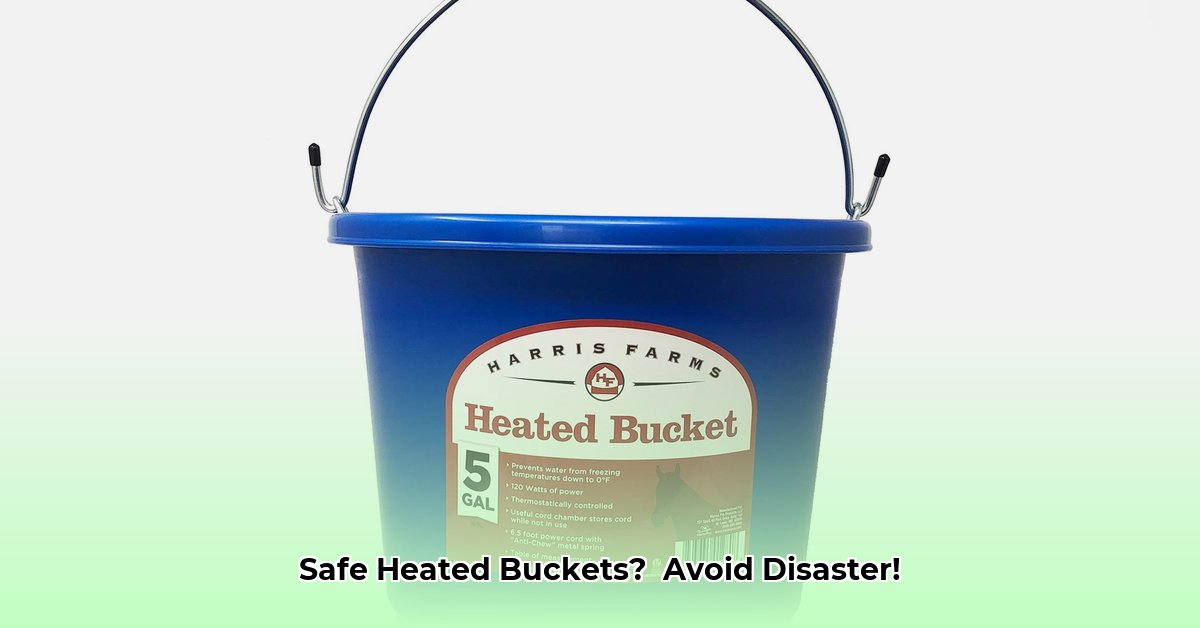
Keeping your livestock well-hydrated, especially during harsh winter conditions, is paramount. Heated water buckets offer a convenient solution, but selecting and using them safely is crucial. A poorly designed or improperly installed heater can pose serious risks to your animals. This guide provides actionable steps for safe selection, installation, and maintenance. For alternative watering solutions, consider exploring galvanized stock tanks.
Understanding the Risks: The Dangers of Inadequate Heated Waterers
Heated livestock waterers, while beneficial, present several significant dangers if not properly chosen and maintained. Electrocution is a primary concern; faulty wiring or submerged heating elements can easily deliver a lethal shock to animals. Fire is another major risk; damaged cords, chewed wires, or malfunctions can easily ignite flammable materials in barns and stables. Lastly, leaks and malfunctions can lead to messy, hazardous situations and potential water contamination. Failing to address these risks can have severe consequences.
Choosing a Safe and Reliable Heated Waterer: A Comparative Review
Selecting the right heated waterer requires careful consideration. Reviews reveal significant variations in quality and safety features among different brands. Some brands, like API, often receive high praise for their robust construction and inherent safety mechanisms; these include sturdy cords and well-shielded heating elements. Conversely, certain budget-friendly models from brands like Farm Innovators have drawn considerable criticism due to flimsy construction and inadequate cord protection. Price shouldn't be the primary factor; the safety of your livestock should come first.
Key Features to Prioritize:
- UL Certification (or equivalent): Look for this safety certification to ensure the product has met established safety standards.
- Ground Fault Circuit Interrupter (GFCI) Protection: This crucial safety feature instantly cuts power if it detects a short circuit, preventing electrocution – essential for electric models.
- Durable Construction: Robust materials resist damage from harsh weather conditions.
- Cord Protection: Well-protected cords resist chewing and prevent accidental damage.
- Waterer Capacity: Choose a size appropriate for your animal's needs.
Comparative Data (Illustrative):
| Brand | Construction Quality | Cord Protection | GFCI Protection | Overall Risk Assessment |
|---|---|---|---|---|
| API | Excellent | Excellent | Typically Included | Low |
| Some Farm Innovators Models | Fair | Poor | May Not Be Included | High |
| Other Brands | Varies | Varies | Varies | Medium |
(Note: This data is illustrative and may not represent every model within a given brand.)
Step-by-Step Guide to Safe Installation and Usage
Proper installation and usage are crucial for preventing accidents. Follow these steps meticulously:
Ground Fault Circuit Interrupter (GFCI) is Mandatory: Always plug your heated waterer into a GFCI-protected outlet. This safety device will instantly cut the power, preventing electrocution in case of a short circuit.
Cord Management is Critical: Protect the cord from damage; animals may chew on it. Use protective conduit or sleeves. Keep the cord away from moisture and secure it to prevent tripping hazards.
Strategic Placement is Important: Place the waterer in a well-drained area, accessible to animals yet away from flammable materials (hay, wooden structures).
Regular Inspections are Essential: Regularly inspect the cord for wear and tear (frayed wires, cuts). Check the bucket for cracks or leaks and ensure the heating element is functioning correctly. Replace the unit if you find any damage. Don’t wait for a failure.
Ongoing Maintenance: A Safety Checklist
Regular maintenance dramatically reduces risk. Use this simple checklist:
- Daily: Check water level and look for signs of freezing.
- Weekly: Inspect cords and the heating element for damage.
- Monthly: Perform a thorough visual inspection of the entire unit.
Advocating for Enhanced Safety Standards
Individual responsibility is paramount, but manufacturers and regulatory bodies must also improve safety standards. Stricter regulations and design improvements incorporating advanced safety features are needed to minimize the risks associated with heated waterers. The well-being of our livestock depends on a collective effort.
"The safety of our animals shouldn't be compromised by inadequate product design or oversight. We need to advocate for stricter standards and better consumer information." - Dr. Emily Carter, Veterinarian, Rural Animal Health Initiative